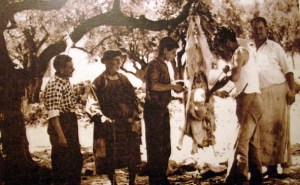Large numbers of pig carcasses are hanging on hooks in butcher shops. Christmas day is near….
Because the pig is the traditional meat for the most regions in Greece. And the days before and after Christmas is the peak of the pig killing season which begins around the feast of St Demetrius (26 October).
Is there a connection between pig slaughtering and ancient animal sacriface?
It is known that ancient Greeks sacrificed pigs to Demeter, greek godess of agriculture and fertility, to her daughter Persephone and the chthonic dieties. Why? Partly because of the special powers attributed to pigs on account of their association with fertility and abundance of flesh and blood. Partly because of their association with dirt; since evil spirits were often equated with dirt, pigs’ death became equated with evil spirits’ death. For the same reasons pigs symbolized the ancient Greek vegetation daemon with the ambivalent powers to give fertility and destruction. Moreover, these animals were particularly important in rituals practiced by and for women (such as Demeter’s festivals). Why? Women were linked to fertility, however like pigs, evil spirits and the dead, they were considered ‘dirty’ when not ritually purified.
But in the year 392 A.D., the Olympic Pantheon was officially pronounced dead by Theodosios the Great, who made Christianity the state religion of the Byzantine Empire. The truth is that the 12 ancient Gods had already declined, despite the fact that Christianity had absorbed many strands of ancient religion and philosophy. Did the animal sacrifices of the pagan Graeco-Roman world decline, as well?
Like a large part of the ancient Greek worshipping system which had been transformed and survived within Christianity – f.i. the hero and heroine cult, the honor paid to the dead etc.- conceptions, faiths, rituals and the strong tradition of animal sacrifice did transform too. Despite the criticism of the Fathers of the Curch, the decisions of Ecumenical and local Synods and the condemnations, animal sacrifice was much common among laymen throughout the Byzantine and post-Byzantine world. Why? Because on the one hand the Church did try to separate its cultic code from this kind of sacrifice but on the other hand it did not reject certain cults and rituals that had derived from the pagan religion. Why? Demetrios Constantelos (Christian Hellenism) has observed that ‘There were at least two distinct cultures during both the ancient and mediæval periods of Greek history: one peasant and one urban and elite. Mediæval peasant culture had more in common with ancient peasant culture than with the contemporary Christian culture of the educated urban elite, since it could more readily accommodate the lower forms of religious beliefs and practices. So, in its attemp to spread the Christian faith, the Church did not systematically reject customs and beliefs that existed before and outside Christianity.
Until the 1960s, pig slaughtering was an important social occasion and a necessity,
for it meant full and plenty for all. Today pig killing is restricted in certain Aegean islands and mountain areas. However, killing and butchering are always done by the men who first make the sign of cross on the pig’s head, but it is always the women who make sausages, cure and smoke bones, meat, fat, cook, etc.
Some of the blood is poured on the fields or on the animals to ensure fertility and prosper through sympathetic magic.


